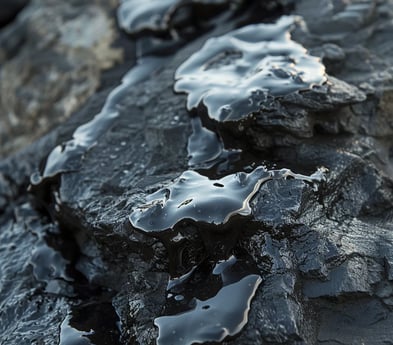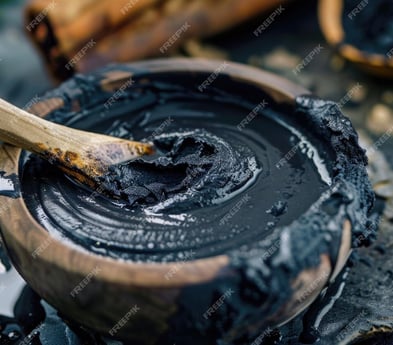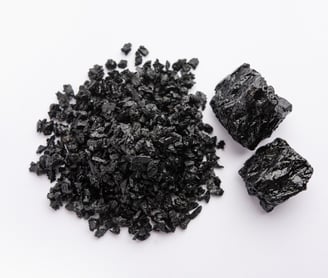Shilajit: The Journey
Shilajit, pronounced "shee-la-jeet," originates from the highest peaks of remote mountains, where ancient plant matter undergoes a gradual breakdown over millions of years, forming large organic deposits through natural processes. As moisture condenses on mountain slopes, it permeates these deposits, gathering natural minerals and beneficial nutrients before precipitating inside caves, crevices, or rocks as Shilajit – a potent black-brown resin.
While it may seem surprising that a sticky substance from rocks holds health benefits, Shilajit has been revered globally for over 3,000 years, with some considering it a panacea. Known for its rejuvenating effects, it supports the immune system and healthy aging, among other benefits.
Translated from Sanskrit, Shilajit means "the destroyer of weakness," highlighting its ability to bring strength and vitality to the body. Unlike typical herbal products, Shilajit isn't directly harvested from plants but forms naturally within rocks.
Packed with essential minerals like silica, iron, and zinc, Shilajit also contains organic trace minerals, fulvic acid, humic acid, amino acids, and plant-based antioxidants. This combination makes it a natural source of over 85 minerals and trace elements vital for optimal bodily function, with fulvic acid aiding mineral absorption at a cellular level.
Utilized as a dietary supplement for millennia in Asia, Shilajit has recently garnered global attention for its potential health benefits. Traditional Ayurvedic medicine has long hailed it as a cure-all, while scientific studies suggest its ability to support immune function, cognitive health, and even longevity. With its captivating reputation, Shilajit is emerging as a favored natural supplement for enhancing overall well-being and vitality.




Suryatapi: A Vital Ayurvedic Technique in Nature's Gift Shilajit Purification
In Ayurveda, the "suryatapi" method refers to a time-honored process of sun-drying used to purify shilajit. This ancient technique, which harnesses the natural energy of sunlight, is crucial in ensuring the quality, potency, and safety of shilajit for medicinal use. Sun-drying allows shilajit to retain its bioactive compounds, while also eliminating impurities, making it an essential step in producing a therapeutic substance that maintains its integrity.
Why Sun Drying Matters
Preserving Potency: Sun-drying shilajit helps safeguard its most important compounds, such as fulvic acid, which can degrade at higher temperatures. The suryatapi method ensures that these health-boosting elements remain intact, maximizing the product’s therapeutic value.
Natural Sterilization: Exposure to sunlight acts as a natural sterilizer, reducing microbial contamination. This adds an extra layer of safety, ensuring that the final product is pure and ready for medicinal use.
Enhancing Vitality: Some studies suggest that the solar energy absorbed during suryatapi enhances shilajit's rejuvenating properties, making it a potent anti-aging remedy.
Modern Adaptations to ancient methods
While suryatapi remains an essential Ayurvedic practice, it does depend on natural conditions like sunlight, which can vary by location and season. To overcome this, modern purification techniques, spectroscopy is used alongside suryatapi to ensure consistency and quality.
The suryatapi method adopted by Nature's GIft is a key part of the traditional purification of shilajit and retaining its almost mythical qualities, while removing all impurities. Although rooted in ancient practices, this technique is combined with modern scientific methods to ensure the highest quality of shilajit for consumers of our Gold Grade Himalayan Shilajit.







Nature's Gift Himalayan Gold Grade Shilajit:
Quality Assured


Discover the Power of Pure Himalayan Shilajit Resin: Why Quality Matters
When it comes to choosing Shilajit - Purity, Potency, and Bioavailability are key to unlocking its full therapeutic benefits. While powdered Shilajit may seem convenient, it's often susceptible to adulteration and contamination, with fillers that dilute its strength and reduce its efficacy. The process of turning Shilajit into powder can cause the loss of vital bioactive compounds—limiting its ability to deliver the nutrients and minerals your body craves.
On the other hand, natural Himalayan Shilajit resin offers a far more powerful solution. This resin form maintains its full spectrum of bioactive compounds, ensuring that you get the potent blend of minerals, fulvic acid, and humic acid that makes Shilajit so revered. Its high bioavailability means your body absorbs these nutrients more effectively, amplifying Shilajit’s natural benefits.
Remember, not all Shilajit is created equal. Sourcing it from reputable suppliers in ecologically balanced regions of the Himalayas guarantees a product free from contaminants and packed with authentic, active ingredients. Choose local harvesters who honour ancient tradition and can ensure the quality and authenticity of superior natural Himalayan Shilajit resin for optimal wellness—because your health deserves nothing less than the best of Nature's Gift.
Adding Shilajit to your Diet
Optimal intake and combination of shilajit is a topic of great interest both in traditional Ayurvedic practice and modern nutritional science. Shilajit, a natural mineral-rich resin, is primarily sourced from the Himalayan region and is known for its many health benefits, including antioxidant, anti-inflammatory and adaptogenic properties. Understanding how to effectively incorporate shilajit into the diet can enhance its therapeutic effects and ensure safe consumption.
Recommended dosage
The appropriate dosage of shilajit may vary based on individual health, age, and specific combination of supplements used. In general, a common recommendation is to start with a low dose, usually around 300 to 500 mg per day, and gradually increase it as it is tolerated. Some studies suggest that doses up to 1,000 mg per day may be beneficial for certain health conditions, but it is important to consult a healthcare professional before exceeding this amount. However the general recommended usage for the average person for general wellbeing benefits should not exceed 500mg.
Recommended time of intake
The timing of shilajit intake can also affect its effectiveness. Many practitioners recommend taking shilajit in the morning on an empty stomach to maximize its energizing effects throughout the day (Meena et al.2). This practice is consistent with the traditional use of shilajit as a rejuvenating agent, helping to combat fatigue and improve physical performance. In addition, taking shilajit before meals can improve digestion and nutrient absorption due to its mineral content
Synergistic effects with other dietary supplements
Shilajit can also be effectively combined with other supplements to enhance the overall health benefits. For example, combining shilajit with ashwagandha, another well-known adaptogen, can produce synergistic effects in reducing stress and improving energy levels. Similarly, combining shilajit with omega-3 fatty acids from fish oil may support cardiovascular health and enhance its anti-inflammatory properties.
Combination with other ingredients
Combining shilajit with other natural substances can enhance its benefits and make it more palatable. For example, mixing shilajit with warm milk or honey can not only mask its strong taste, but also provide additional health benefits. Milk is known for its calcium and protein content, while honey adds natural sweetness and has its own antioxidant properties (Velmurugan et al.5). Furthermore, combining shilajit with herbal teas, such as ginger or basil, can enhance its adaptogenic effects and help the body deal with stress more effectively.
Health Warning
Although pure traditionally refined and tested shilajit is well tolerated by many, some individuals may experience mild side effects, such as gastrointestinal discomfort or allergic reactions. In rare cases, excessive intake can lead to negative effects, including increased heart rate or dizziness. Monitoring your body's response to shilajit and adjusting your dose accordingly can help reduce these risks.
Heavy Metal Content
Although shilajit is generally considered safe for most people, it is important to ensure that the product is of high quality and free of contaminants. Some shilajit products may contain heavy metals or other impurities, which may pose health hazards (Velmurugan et al.5). Therefore, it is crucial to obtain shilajit from reputable suppliers who conduct thorough testing for purity and potency. In addition, people with specific health conditions, such as those with iron overload disorders, should consult a healthcare professional before using shilajit, as it may increase iron absorption
Long-Term Benefits
Long-term use of shilajit has been associated with various health benefits, including improved energy levels, improved cognitive function and better immune response (Mishra et al.3; Review1). Regular consumption may also support overall vitality and longevity, in keeping with its traditional use as a rasayana (rejuvenator) in Ayurveda (Meena et al.2). However, periodic breaks from supplementation may be advisable to prevent potential tolerance or addiction.


Esther Bryce
Founder / Interior designer


Lianne Wilson
Broker


Jaden Smith
Architect


Jessica Kim
Photographer












